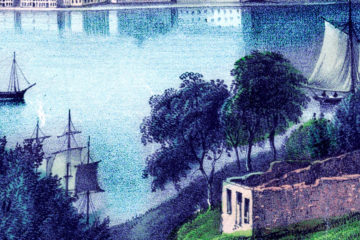On my recent trip to Dublin, I loaded up on Irish history books that one generally can’t find in the United States outside the realm of Amazon, which I’m trying to use less often. The pile of books significantly increased the poundage of our luggage, but I always find it worth the effort. Also, the Butler’s chocolates contributed to the heft.
One of the books I picked up was John Gibney’s recent survey A Short History of Ireland 1500-2000.

This book is a solid introduction to the politics and economics of Ireland, particularly as they relate to religion and Ireland’s relationship with England/Britain. Gibney begins with the Tudor era and control that powerful Gaelic-Irish men had over large areas of the island. He covers the impact of the English Reformation, especially how religion divided the Gaelic Irish from the English who settled there. He goes on to explain the Plantation of Ulster, the so-called Glorious Revolution, the emergence of an Irish identity in the 1700s, the Famine and the fight for Home Rule, and of course the major events of the Twentieth Century, especially the Easter Rising and War for Independence. Gibney definitely hits the highlights of the past 500 years of Irish history.
He doesn’t go into depth on any of these issues, so this book isn’t for seasoned scholars of Ireland. But, if you have an emerging interest in Irish history, you can definitely get a feel for the path that Ireland has taken in modern history (if we consider modern from about the year 1500, or at the earliest the beginning of the Renaissance about 100 years earlier). Gibney addresses a lot of issues that will have curious readers thinking, “I want to know more about that!” I really think he gave short shrift to Daniel O’Connell, the Liberator, who towered over the first half of the 1800s in Ireland. O’Connell was a remarkable figure in Irish history, and he had an impact on people around the world, too–a fact that is not at all clear in this volume.
Still, the book left me with some questions that I now want to explore further. For example, Gibney writes, “…the period of economic growth in the later 1960s became a time of considerable educational reform, with a great emphasis on modernising an outdated system and making it as widely accessible as possible” (223). But, he doesn’t tell us what it meant to “modernize” the Irish educational system, and he does note that it was still dominated by the Catholic church. I’m eager to know how the system changed.
The author makes a claim that in 1966, “the [fiftieth] anniversary of the rising was also an opportunity to articulate a critique of a state that, for many, was an abject failure when judged by the benchmark of the principles of the rising (at least as contained in the famous proclamation)” (224). While it is true that Pearse’s proclamation of Poblacht na hÉireann offered “equal rights and equal opportunities to all [Ireland’s] citizens,” the Proclamation said little about the vision for a sovereign Irish republic. I think this is an important point that Gibney leaves out of his analysis–there was no clearly articulated vision for an Ireland free of British rule.
As a former history teacher, I appreciate that this book includes short sections titled “Where Historians Disagree” at the end of each chapter. These short sections give a lay audience a basic understanding of what historians do, and the concept of historiography. I wish more history books that are written for a lay audience would in some fashion teach the reader that history is not merely “what happened in the past.” A popular falsehood propagated in some circles (notably by irishcentral.com) is that the Famine was a genocide, and I’m glad that Gibney asserts that no serious scholar of Ireland would make that claim. He also notes differences in opinions among historians about the extent and nature of sectarian violence and discrimination in both Éire and Northern Ireland.
Gibney’s book fails in one key respect: its treatment of women in Irish history. Indeed, at the end of his book, Gibney refers to women’s history as “niche.” And my blood pressure spiked 20 points. Niche? Really? I suppose if one is still inclined to follow the archaic “add women and stir” approach to women’s history, then it makes some more sense to omit women from this text. But that approach has been vanquished for a good reason–women are not somehow separate from history; they are an integral part of every era. In particular, Gibney should have discussed the role of women in the Protestant Reformation in Ireland (or their role in resisting it). Women have historically been guardians of the faith in many religions, and surely their part was relevant here. Thus, a better understanding of this book is “A Short Political History of Ireland,” as politics and the relationship between Ireland and Britain are the main focuses–and women were left out of formal politics until the mid-1900s.
So, if you have a burgeoning interest in Irish history, this book is a solid place to start. Just be sure to make notes along the way of topics you want to learn more about.

0 Comments